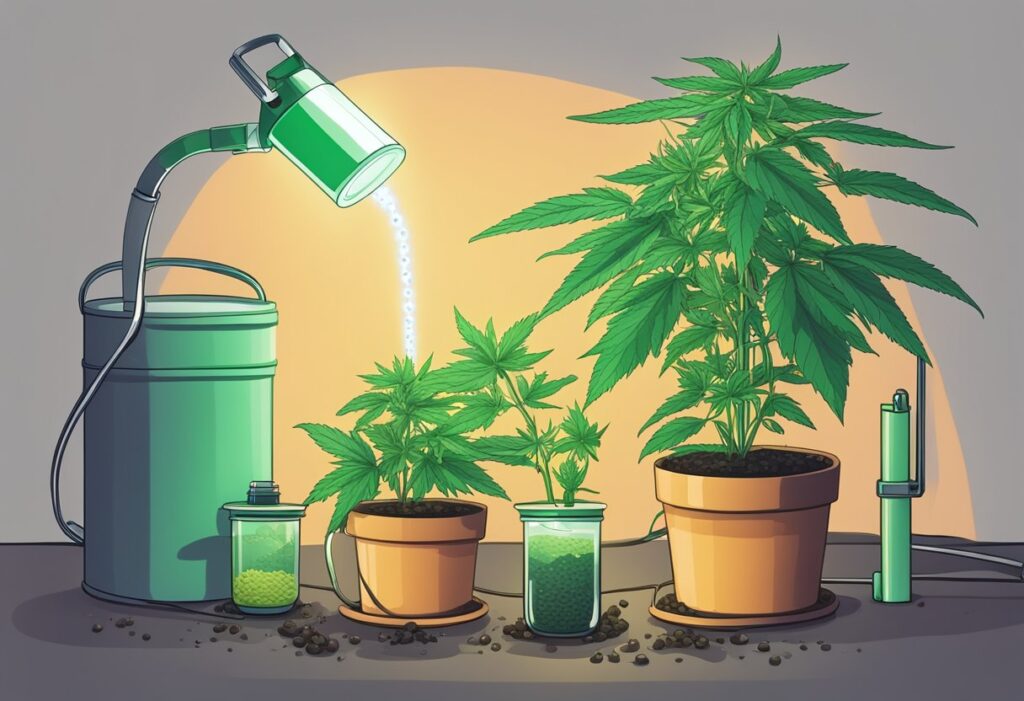
Autoflowering cannabis plants are a unique type of cannabis strain that differs from photoperiod plants in many ways. These plants are known for their fast growth cycle, which ranges from seed to harvest in as little as 8 to 10 weeks. Autoflowers are also smaller in size and generally have lower yields when compared to photoperiod plants.
The genetics of autoflowering cannabis plants are different from photoperiod plants. Autoflowers are bred by crossing different strains of cannabis plants with a specific strain of Cannabis ruderalis. This strain is known for its ability to flower based on age, rather than the light cycle. As a result, autoflowers do not require a specific light cycle to start flowering, making them ideal for indoor cultivation.
The growth cycle of autoflowers is also different from photoperiod plants. Autoflowers have a predetermined life cycle that ranges from seed to harvest in a short period of time. The growth cycle of autoflowers consists of three main stages: germination, vegetative stage, and flowering stage. The vegetative stage is short and lasts for only 2 to 4 weeks, while the flowering stage can last for up to 8 weeks.
Autoflowering cannabis seeds are perfect for the Canadian climate because they have a short life cycle and can be grown indoors. When growing autoflowers in Canada, it is important to provide optimal growing conditions to ensure maximum yield and potency.
Here are some optimal growing conditions for autoflowers in Canada:
By providing optimal growing conditions, you can ensure that your autoflowering cannabis plants grow to their full potential and produce high-quality buds.
Growing autoflower seeds in Canada can be a rewarding experience, but it requires careful management of nutrients. Nutrient management is essential to ensure that your plants grow healthy and produce high-quality buds. In this section, we will discuss some of the key factors to consider when managing nutrients for autoflowers.
The first factor to consider is the quality of the soil. Autoflowers require well-draining soil that is rich in nutrients. The pH of the soil should be between 6.0 and 7.0. This range is slightly acidic to neutral, which is optimal for nutrient uptake. If the pH is too high or too low, it can cause nutrient deficiencies or nutrient lockout.
Autoflowers require both macronutrients and micronutrients to grow healthy. Macronutrients are nutrients that plants require in large quantities, such as nitrogen, phosphorus, and potassium. Micronutrients are nutrients that plants require in small quantities, such as iron, magnesium, calcium, and sulfur. It’s essential to provide the right balance of macronutrients and micronutrients to avoid nutrient deficiencies or nutrient burn.
Feeding schedules and dosages are critical when managing nutrients for autoflowers. Overfeeding or underfeeding can cause nutrient burn or nutrient deficiencies. It’s essential to follow a feeding schedule that is appropriate for the growth stage of your plants. During the vegetative stage, plants require more nitrogen, while during the flowering stage, they require more phosphorus and potassium. It’s also important to adjust the strength of your nutrients based on the needs of your plants. Slow-release nutrients, bottled nutrients, and organic nutrients are all viable options for feeding your plants.

When it comes to growing autoflower seeds in Canada, maximizing performance is key to achieving a bountiful harvest. There are a few things you can do to optimize your yield and prevent common issues.
Harvesting your autoflower plants at the right time is essential to achieving maximum yields. Generally, autoflowers have a shorter flowering phase than photoperiod strains, so it’s important to keep a close eye on your plants to determine when they are ready to be harvested.
One way to determine if your plants are ready for harvest is by examining the trichomes. When the trichomes turn milky white, it’s a sign that the buds are mature and ready to be harvested. However, if you wait too long, the trichomes may turn amber, which can result in a decrease in potency.
Another way to optimize your yield is by providing your plants with high-quality nutrients. Autoflowers require less nutrients than photoperiod strains, but it’s important to provide them with the right balance of nutrients to ensure they grow healthy and strong.
One common issue that can arise when growing autoflower seeds is overwatering. Overwatering can lead to root rot and other problems, so it’s important to ensure that your plants are not sitting in water for extended periods of time.
Pests can also be a problem when growing autoflowers. To prevent pests, it’s important to keep your grow area clean and free of debris. You can also use natural pest control methods, such as neem oil or ladybugs, to keep pests at bay.
Finally, using low-stress training techniques can help optimize your yield. By gently bending and shaping your plants, you can encourage them to grow in a way that maximizes their exposure to light and promotes healthy photosynthesis.
Overall, by providing your autoflower seeds with high-quality nutrients, optimizing their light exposure and using low-stress training techniques, you can ensure that your plants grow healthy and strong, resulting in a bountiful harvest of high-quality buds.
The optimal feeding schedule for autoflowering plants in soil depends on the specific strain and the stage of growth. Generally, it’s recommended to start with a light feeding schedule and gradually increase the nutrient levels as the plant grows. Most growers recommend feeding the plants every other watering, but it’s important to monitor the plants’ response to the nutrients and adjust the feeding schedule accordingly.
There are many nutrient brands available on the market, but it’s important to choose a brand that is specifically formulated for autoflowering cannabis. Some of the popular brands include General Hydroponics, Fox Farm, and Advanced Nutrients. It’s recommended to do research and read reviews before choosing a nutrient brand to ensure it is effective and safe for your plants.
During the vegetative stage, autoflowers require higher levels of nitrogen to promote healthy leaf growth. During the flowering stage, they require higher levels of phosphorus and potassium to promote flower development. It’s important to monitor the plants’ response to the nutrients and adjust the levels accordingly. Avoid overfeeding the plants as this can lead to nutrient burn and other issues.
Autoflowering cannabis requires the same essential nutrients as other cannabis plants, including nitrogen, phosphorus, potassium, calcium, magnesium, and sulfur. In addition, they require smaller amounts of micronutrients such as iron, zinc, and manganese. It’s important to provide these nutrients in the correct ratios and at the appropriate times to ensure healthy growth and development.
Nutrients should be introduced to autoflowers during the seedling stage, once the plant has developed its first set of true leaves. It’s important to start with a light feeding schedule and gradually increase the nutrient levels as the plant grows. Avoid overfeeding the plants as this can lead to nutrient burn and other issues.
We ship and deliver world wide via USPS and various couriers.
We offer a wide range of secure and anonymous online payment options.
We care about you, our customer. Please contact us with any questions or concerns.
Find out more about the benefits of being a loyal and regular customer.
WE ARE EVERY GROWERS ONE STOP SHOP TO ACQUIRE PREMIUM CANNABIS SEEDS FOR SALE IN THE USA, CANADA AND AUSTRALIA

Farmers Lab Seeds 2024, | All Right Reserved
Seeds are sold as novelty items, souvenirs, and collectibles. They contain 0% THC. We encourage our customers to check the legislation in their Country, State, Province, and Municipality prior to purchasing items from our store. We do not provide growing information.
All seeds are sold as hemp, and lab tested under 0.3% THC. This product is not for use by or sale to persons under the age of 21. This product should be used only as directed on the label. It should not be used if you are pregnant or nursing. Consult with a physician before use if you have a serious medical condition or use prescription medications. A Doctor’s advice should be sought before using this and any supplemental dietary product. All trademarks and copyrights are property of their respective owners and are not affiliated with nor do they endorse this product.
These statements have not been evaluated by the FDA. This product is not intended to diagnose, treat, cure or prevent any disease. Individual weight loss results will vary. By using this site, you agree to follow the Privacy Policy and all Terms & Conditions printed on this site. Void Where Prohibited by Law.